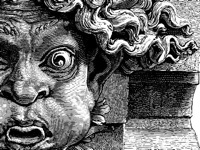Difference between revisions of "Grotesque"
m (Text replacement - "http://nordan.daynal.org" to "https://nordan.daynal.org") |
m (Text replacement - "http://" to "https://") |
||
| Line 3: | Line 3: | ||
==Etymology== | ==Etymology== | ||
Middle French & Old Italian; Middle French, from Old Italian (pittura) grottesca, [[literally]], cave painting, feminine of grottesco of a cave, from grotta | Middle French & Old Italian; Middle French, from Old Italian (pittura) grottesca, [[literally]], cave painting, feminine of grottesco of a cave, from grotta | ||
| − | *Date: [ | + | *Date: [https://en.wikipedia.org/wiki/16th_Century 1561] |
==Definitions== | ==Definitions== | ||
*1 a : a style of decorative [[art]] characterized by fanciful or fantastic [[human]] and [[animal]] forms often interwoven with foliage or similar figures that may distort the [[natural]] into absurdity, ugliness, or caricature | *1 a : a style of decorative [[art]] characterized by fanciful or fantastic [[human]] and [[animal]] forms often interwoven with foliage or similar figures that may distort the [[natural]] into absurdity, ugliness, or caricature | ||
| Line 9: | Line 9: | ||
*2 : one that is '''grotesque''' | *2 : one that is '''grotesque''' | ||
==Description== | ==Description== | ||
| − | The word '''grotesque''' comes from the same [[Latin]] root as "Grotto", [[meaning]] a small cave or hollow. The [[original]] meaning was restricted to an extravagant style of Ancient [[Roman]] decorative art rediscovered and then copied in Rome in the [ | + | The word '''grotesque''' comes from the same [[Latin]] root as "Grotto", [[meaning]] a small cave or hollow. The [[original]] meaning was restricted to an extravagant style of Ancient [[Roman]] decorative art rediscovered and then copied in Rome in the [https://en.wikipedia.org/wiki/15th_Century 15th century]. The "caves" were in fact rooms and corridors of the [https://en.wikipedia.org/wiki/Domus_Aurea Domus Aurea], the unfinished palace complex started by Nero after the great fire from AD 64, which had become overgrown and buried, until they were broken into again, mostly from above. |
| − | In [https://nordan.daynal.org/wiki/index.php?title=English#1500-present.09THE_MODERN_ENGLISH_PERIOD modern English], grotesque has come to be used as a general adjective for the strange, fantastic, ugly, incongruous, unpleasant, or bizarre, and thus is often used to describe weird shapes and distorted forms such as [ | + | In [https://nordan.daynal.org/wiki/index.php?title=English#1500-present.09THE_MODERN_ENGLISH_PERIOD modern English], grotesque has come to be used as a general adjective for the strange, fantastic, ugly, incongruous, unpleasant, or bizarre, and thus is often used to describe weird shapes and distorted forms such as [https://en.wikipedia.org/wiki/Halloween Halloween] masks. More specifically, the grotesque forms on [https://en.wikipedia.org/wiki/Gothic_architecture Gothic buildings], when not used as drain-spouts, should not be called [https://en.wikipedia.org/wiki/Gargoyle gargoyles], but rather referred to simply as grotesques, or chimeras.[https://en.wikipedia.org/wiki/Grotesque] |
[[Category: The Arts]] | [[Category: The Arts]] | ||
Latest revision as of 00:16, 13 December 2020
Etymology
Middle French & Old Italian; Middle French, from Old Italian (pittura) grottesca, literally, cave painting, feminine of grottesco of a cave, from grotta
- Date: 1561
Definitions
- 1 a : a style of decorative art characterized by fanciful or fantastic human and animal forms often interwoven with foliage or similar figures that may distort the natural into absurdity, ugliness, or caricature
- b : a piece of work in this style
- 2 : one that is grotesque
Description
The word grotesque comes from the same Latin root as "Grotto", meaning a small cave or hollow. The original meaning was restricted to an extravagant style of Ancient Roman decorative art rediscovered and then copied in Rome in the 15th century. The "caves" were in fact rooms and corridors of the Domus Aurea, the unfinished palace complex started by Nero after the great fire from AD 64, which had become overgrown and buried, until they were broken into again, mostly from above.
In modern English, grotesque has come to be used as a general adjective for the strange, fantastic, ugly, incongruous, unpleasant, or bizarre, and thus is often used to describe weird shapes and distorted forms such as Halloween masks. More specifically, the grotesque forms on Gothic buildings, when not used as drain-spouts, should not be called gargoyles, but rather referred to simply as grotesques, or chimeras.[1]
